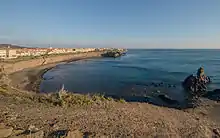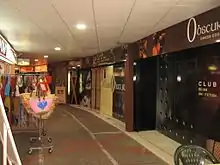
Cap d'Agde (French pronunciation: [kap daɡd]) is a seaside resort on France's Mediterranean coast. It is located in the commune of Agde, in the Hérault department within the region of Occitanie. Cap d'Agde was planned by architect Jean Le Couteur as part of one of the largest state-run development schemes in French history.[1] In the 1960s, the only buildings at the Cap were small houses that were typically used by locals over the weekends. It is now one of the largest leisure ports on the French Mediterranean.
Agde can be reached by TGV SNCF train direct from Paris or Lille whilst the closest airport is Béziers-Cap-d'Agde airport, which runs direct budget airline services to the UK and Scandinavia. Cap d'Agde is also served by Montpellier-Fréjorgues airport. Public transport (taxi or bus) is available between Agde and Cap d'Agde.
The Musée de l'Ephèbe houses the bronze nude statue known as "l'Ephèbe d'Agde" ("the Youth of Agde"). The statue was discovered in the river Hérault and was housed in the Louvre Museum prior to suitable facilities being made available in Cap d'Agde to house it.
Naturist village


Cap d'Agde has a large naturist resort.[1] The village naturiste forms a large part at the north-eastern edge of Cap d'Agde (43°17′42″N 03°31′38″E / 43.29500°N 3.52722°E). It is fenced-off with an entrance gate, and it is also accessible along the public beach from the east. It is a self-contained town (sometimes referred to as the "Naked City"), where nudity is both legal and common. In the evening, when it gets colder, more people are dressed, sometimes in revealing clothes. A local tourist tax is charged per person, per day.
The Naturist Village is becoming a hotspot for swingers and libertines.[2][3] It has a 2 km (1 mi) beach, a large marina, places for 2,500 campers, apartment complexes, hotel, shops, restaurants, night clubs, bars, post office, bank, ATMs, launderettes, hairdressers, and other facilities.
History of local naturism
The land adjoining the long sandy beach at Cap d'Agde was owned for many years by the Oltra family who farmed the olive groves behind the sand dunes adjoining the beach. After the Second World War the brothers Oltra noticed that people were coming in increasing numbers to camp on their land, and that many of these people liked to bathe and to sunbathe nude.
The Oltra brothers began to formalise arrangements for campers on their land, and this subsequently led to the creation of a caravanning and camping resort, called the 'Oltra Club' . The camp grew increasingly popular, especially with young families and German and Dutch tourists.
In the early 1970s the government of Georges Pompidou drew up plans for the development of the Languedoc-Roussillon coastline. Naturism initially had no part in these proposals, but Paul René Oltra, one of the brothers, persuaded the authorities to include plans for a naturist resort at Cap d'Agde.[4] In 1973 the beach was officially designated as a naturist beach. Regulations for the new resort were also promulgated. The Naturist Village would be a place where voyeurs and exhibitionists would not be welcome.
Early developments
The first development was the construction of flats, shops and pools at Port Nature and Port Ambonne. Later, Heliopolis and Port Venus were built and Port Nature was considerably extended. The flats were sold and the owners often let them when they did not require them for their own use. The Naturist Village became a controlled zone during the season with regulated access. Everyone entering was informed of the regulations and required to comply with them.
The 1980s
By the early 1980s, the Naturist Village was reaching the limit of its development. Many shops and commercial premises remained empty, ready for sale or lease. The election of the government of François Mitterrand was to herald a cooling off of the French economy which lasted well into the following decade. During this time the Naturist Village continued to prove a popular resort and it developed a relaxed and pleasant atmosphere. There were so many German visitors that the Post Office even had a designated postbox for letters and postcards being sent to Germany.
The present position


The naturist village is also becoming a hotspot for swingers and libertines, with sex-shops and swinger clubs. The swingers are also active on the naturist beaches, which has made many naturist tourists change destination to family friendly naturist resorts.[2][3] The nickames is "La baie des cochons".[5]
The naturist village has rules which require nudity as the norm, and which ban photography, the wearing of provocative clothing and the display of indecent items. In 2008, signs were put on display on the beach warning against lewd behaviour. The nightlife centres around clubs and venues. Many open only at certain times of the year. On 23 November 2008, the British newspaper The Sunday Times suggested that fires at three swingers clubs were started by hard-line naturists, or 'nudist mullahs', who oppose the echangistes or libertines.
In 2009, René Oltra, the company that bears the name of the resort's original promoter, required that visitors to its campsite, villas and flats belong to a naturist organisation. However, because of abuses, Cap d'Agde is no longer registered with or supported by the Fédération Française de Naturisme.
In December 2009, the local authority proposed renovations that would make the village almost traffic-free. These renovations involved the construction of tree-lined walkways and promenades, a raised promenade by the beach, and a hotel. Work was to start in early 2012. Other plans included the renovation of buildings and the construction of new façades.
The naturist village creates employment and revenue in a region of France less affluent than others. It creates income for the local authority through property taxes and admission prices.
In September 2020, during the COVID-19 pandemic it was reported that a testing station outside the village found 30% of 800 naturists tested positive for COVID-19. Under normal circumstances at the time—much reduced during the pandemic–the village itself held 10,000 campsite pitches and 15,000 beds, a population density seven times greater than nearby Montpellier.[6]
Naturist beach

The naturist beach (where nudity is technically mandatory) has a length of about 2 kilometres (1 mile) and is about 30 metres (100 feet) wide. Sand and water are of good quality, the latter varying from 16 to 22 °C (61 to 72 °F). Two security posts feature police and medical facilities. Lifeguards are on duty at several stations, during most of the day. Six restaurants border the southern end of the nude beach. Only one restaurant is available towards the northern end. Even though Cap d'Agde is in France, most of the service staff also speak English.
Marina
The marina has about 60 places for boats up to 17 metres (56 ft) in length and a large boat yard.
See also
Notes and references
- 1 2 Hoad, Phil (27 August 2015). "Welcome to the naked city: sun, swingers and very little shoplifting". The Guardian. Retrieved 2015-09-14.
- 1 2 DENESTEBE, Florence (16 September 2010). "Quartier Naturiste du Cap d'Agde: Parlons en sans tabou!" [Cap d'Agde Naturist Quarter: Let's talk without taboo]. Hérault Tribune (in French). Retrieved 2015-08-27.
- 1 2 Beaugé, Marc; Delmas, Gino (29 July 2012). "Les Inrocks - Baie des cochons: bienvenue sur la plage libertine du Cap-d'Agde" [Bay of Pigs: welcome to the libertine beach of Cap d'Agde]. Les Inrocks (in French). Retrieved 2015-08-27.
- ↑ "Das ist eine autonome Nacktwelt" [This is an autonomous nude world]. Süddeutsche Zeitung (in German). 5 September 2010. Retrieved 2019-03-29.
- ↑ "Libertinage : coup de blues sur la "baie des cochons"". midilibre.fr (in French). Retrieved 2023-11-20.
- ↑ "The nudists spreading coronavirus in a French resort". BBC News. 2 September 2020.